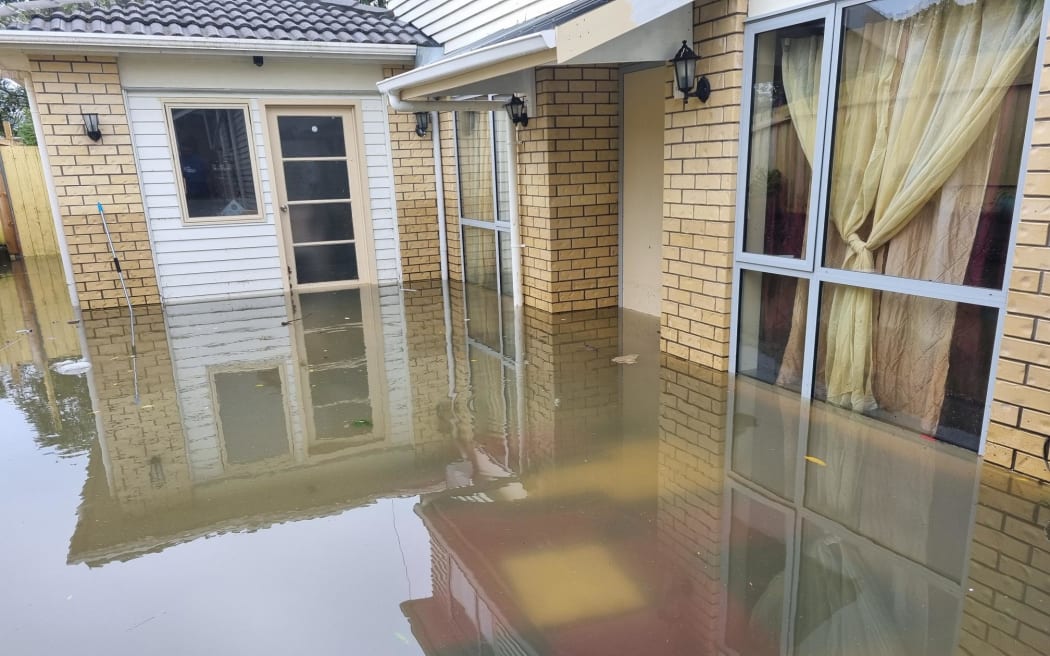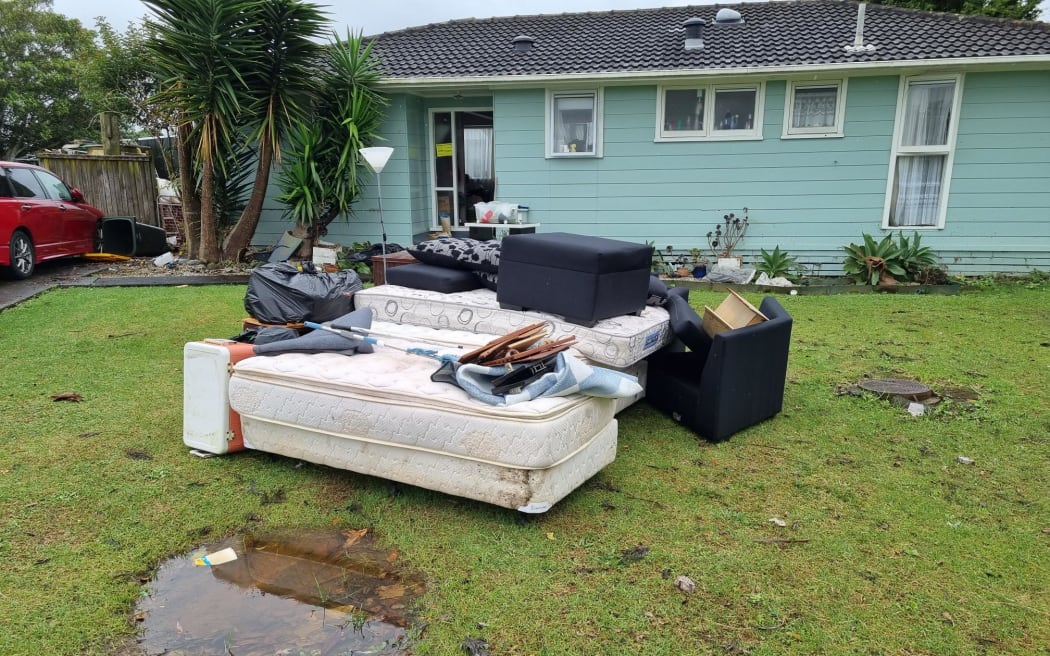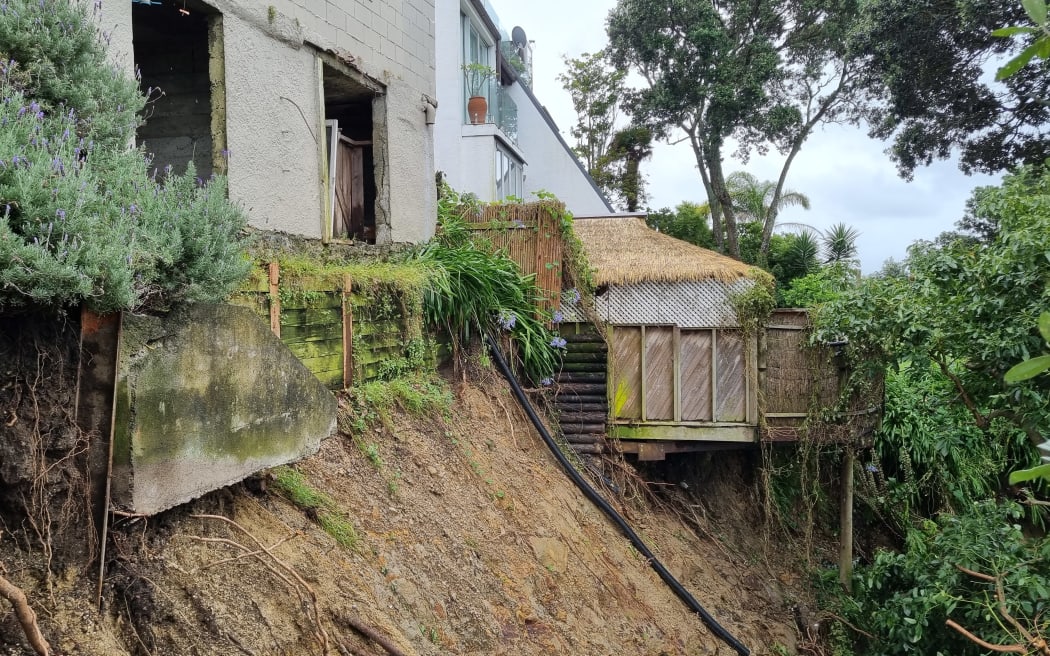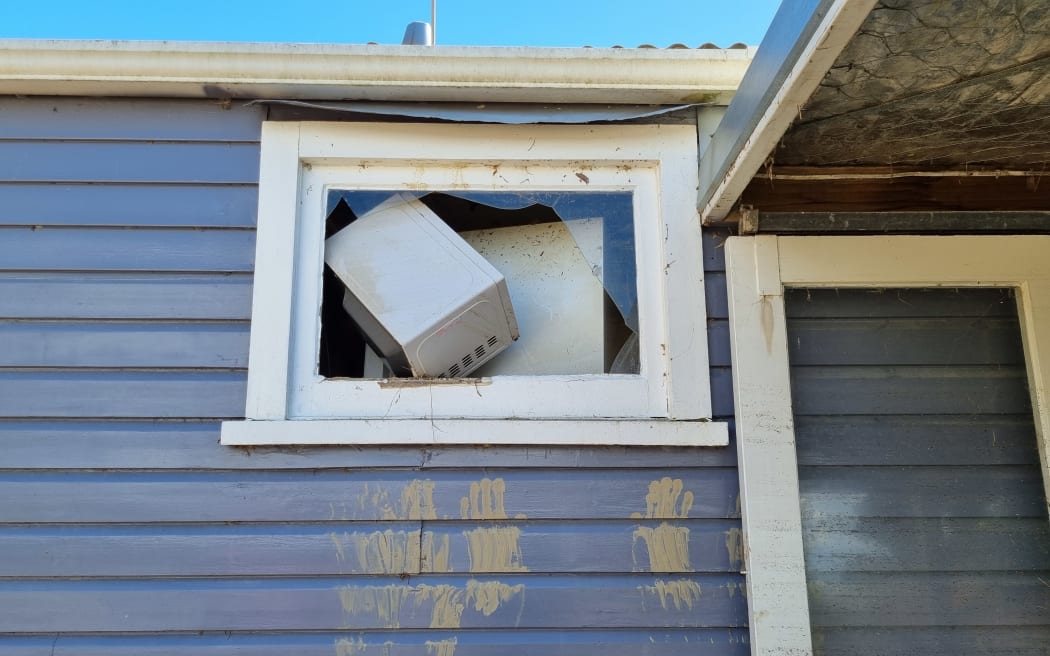
Around 7000 Auckland properties were affected by historic flooding in the city a year ago. Photo: RNZ / Rayssa Almeida
More than 1400 new house consents have been granted in flood plains in Auckland since devastating flooding damaged thousands of homes a year ago.
The latest numbers were published just days before the council launched a 'Be Prepared' campaign encouraging Auckland residents to prepare for and protect their homes from future flooding.
An Auckland councillor says the numbers are frustrating but councils are hamstrung by current planning rules and a lack of direction from central government.
The latest monthly housing update published by the council shows 1873 new dwellings were consented in known hazard zones between February and November 2023.
Of those, 1415 were on flood plains (areas where runoff from waterways will flow) - more than 10 percent of all new homes consented in that time.
Consents were also granted for 798 dwellings in flood prone areas - natural and human-made features like depressions, dips and gullies where rainwater can collect.
Some dwellings may be in both types of flood zone.
The council could not provide a breakdown of where the consents had been granted.
However, the spokesperson for community group West Auckland is Flooding, Lyall Carter, said brand-new houses had been built in Henderson streets that were flooded last January.
"I would imagine [they were consented] pre-flood.
"But they know the areas that were flooded. Surely they would then go, 'Hey, why don't we just put a stop on building in these areas until we can assess it properly.'"
The risk of flooding for both types of hazard is one percent in any given year (typically referred to as a one-in-100-year flood).
Climate change researchers have warned the public and planners that the risk - and therefore the frequency - will increase dramatically in future decades.
NIWA estimated last year's floods, which killed four people, were a one-in-200-year event, but the areas that flooded closely matched Auckland Council modelling.

Damaged property at a Mangere home in last year's Auckland floods. Photo: RNZ / Jonty Dine
Victoria University Economics of Disasters and Climate Change chair Ilan Noy said it was so obvious that new dwellings should no longer be consented on flood plains "that it's almost not worth mentioning".
Every new home built in a known flood zone was a new managed retreat risk, Noy said.
"It doesn't make any sense to allow these consents when we know with almost 100 percent certainty that sometime in the future - and probably not in the very distant future - the government will have to buy these properties back at an incredible cost.
"That knowledge is still there - so why are we still doing this?"
However, the current Resource Management Act (RMA) often made it difficult for councils to refuse consent, he said.
"I frequently hear the complaint that the existing legal tools are not sufficient, especially because a lot of times the landowners will take local council to the Environment Court, and typically councils would lose."
That made him hesitant to blame Auckland Council or any other local authority.
"To me it seems it's a failure of central government.
"The big picture is that we need a legal framework that does not create those situations, and we don't have that - we've been talking about that for the last six or seven years."

Ponsonby properties severely affected by the extreme weather event in Auckland last year. Photo: RNZ/ Robin Martin
The previous Labour government passed legislation designed to replace the RMA just before the last election, but both the Spatial Planning Act and the Natural and Built Environment Act were repealed by the new government just before Christmas.
Labour's legislation was "not perfect" but was "way better" than the RMA, Noy said.
"I appreciate the fact that different governments have different approaches and different ideologies but I don't think you repeal something before you have something to replace it," he said.
"If the new government has a different system that they think is better than the system proposed by the previous government then by all means implement it. But just repealing it is not an answer."

Victoria University's Ilan Noy Photo: supplied
Auckland councillor Richard Hills, head of the council's Planning, Environment and Parks committee, agreed with Noy that local authorities were "hamstrung" by current planning laws that allowed applicants to go ahead if they could show they had taken reasonable steps to reduce the risk.
"Essentially, when consent holders can prove through their engineers, lawyers, whoever, that they can mitigate the risk and they believe that lifting the floor level, or only putting structures that won't have people living, sleeping - so garages or basements - and that's a level of risk they're willing to take, then those things will get consent."
Since the floods,the council had been taking a second look at some greenfields sites that had been zoned for residential development, Hills said.
"We will be looking to down-zone some areas but that will be controversial … and it's not just something we can do overnight."
However, the council could not do that until it implemented a previous planning change that required councils around the country to allow for more intensive development.
Hills said it would make more sense to combine the two processes and both councillors and staff were hoping to get permission from the new government to do just that.

Widespread damage and loss of life resulted from Cyclone Gabrielle, which followed immediately after the Auckland floods last year. Photo: RNZ / Soumya Bhamidipati
In response to the 2023 Auckland floods and Cyclone Gabrielle, the previous government had also drafted a National Policy Statement on Natural Hazard Decision-making, designed to give councils clearer direction about how to manage natural hazards when making planning decisions.
A Ministry for Environment spokesperson said submissions on that statement closed on November 20 and were being assessed by officials.
"A briefing will be provided to Ministers to seek direction on next steps."
Hills hoped the new government would persevere with that work.
"People need answers about what the future looks like … so I hope that even if they change or tweak that National Policy Statement, that they use as much of the information as they've gained so far to continue.
"I know that [Prime MInister Christopher] Luxon and [Labour leader Chris] Hipkins said in one of the debates that they would work together on a bipartisan approach to adaptation, managed retreat and planning for climate change so I really hope that was genuine."
Auckland Council director of regulatory services Craig Hobbs said despite the difficulties councils faced, newer building regulations and other rules did seem to be helping.
"As a result of the flooding back in February, around 7000 properties were placarded with either the red, orange or white. Of those, only 100 that were impacted had received a building consent since 2016, which suggests that the conditions we impose on those consents have actually worked."
The council had also introduced a stormwater compliance team that was identifying and cracking down on breaches, as well as making its flood maps easier to use through its online Flood Viewer, Hobbs said.
RMA Reform Minister Chris Bishop's office referred RNZ's questions to Climate Change Minister Simon Watts.
In a written statement, Watts said he looked forward to receiving officials' analysis of submissions on the National Policy Statement on Natural Hazard Decision-making in the next few weeks.
"This will inform government decisions on how we can support local government to consistently consider the risks, while also making sure we provide the homes we need."


